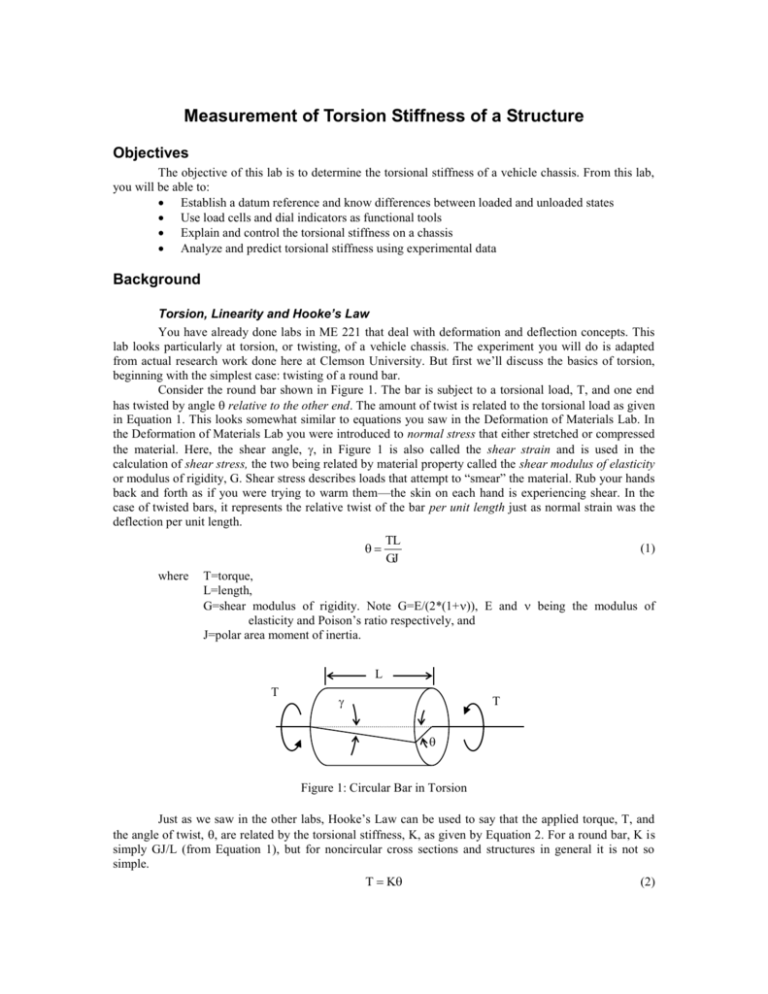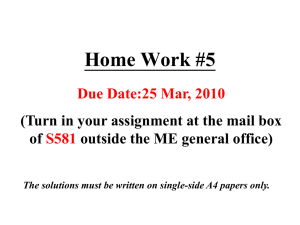Torsion of Formula SAE Chassis
advertisement

Measurement of Torsion Stiffness of a Structure Objectives The objective of this lab is to determine the torsional stiffness of a vehicle chassis. From this lab, you will be able to: Establish a datum reference and know differences between loaded and unloaded states Use load cells and dial indicators as functional tools Explain and control the torsional stiffness on a chassis Analyze and predict torsional stiffness using experimental data Background Torsion, Linearity and Hooke’s Law You have already done labs in ME 221 that deal with deformation and deflection concepts. This lab looks particularly at torsion, or twisting, of a vehicle chassis. The experiment you will do is adapted from actual research work done here at Clemson University. But first we’ll discuss the basics of torsion, beginning with the simplest case: twisting of a round bar. Consider the round bar shown in Figure 1. The bar is subject to a torsional load, T, and one end has twisted by angle relative to the other end. The amount of twist is related to the torsional load as given in Equation 1. This looks somewhat similar to equations you saw in the Deformation of Materials Lab. In the Deformation of Materials Lab you were introduced to normal stress that either stretched or compressed the material. Here, the shear angle, , in Figure 1 is also called the shear strain and is used in the calculation of shear stress, the two being related by material property called the shear modulus of elasticity or modulus of rigidity, G. Shear stress describes loads that attempt to “smear” the material. Rub your hands back and forth as if you were trying to warm them—the skin on each hand is experiencing shear. In the case of twisted bars, it represents the relative twist of the bar per unit length just as normal strain was the deflection per unit length. where TL GJ (1) T=torque, L=length, G=shear modulus of rigidity. Note G=E/(2*(1+)), E and being the modulus of elasticity and Poison’s ratio respectively, and J=polar area moment of inertia. L T T Figure 1: Circular Bar in Torsion Just as we saw in the other labs, Hooke’s Law can be used to say that the applied torque, T, and the angle of twist, , are related by the torsional stiffness, K, as given by Equation 2. For a round bar, K is simply GJ/L (from Equation 1), but for noncircular cross sections and structures in general it is not so simple. T K (2) Having no handy method like Equation 1 from which to extract the stiffness of arbitrary structures, we can still expect that K may be determined by regression analysis (fitting a line) of experimentally obtained angle of twist and inputted torque data. Also, since modifications to the structure will change the torsional stiffness of the structure, torsion testing may be used to identify those parts of the structure that contribute significantly to the torsional stiffness. That’s what this lab is about. Experimental Considerations However, applying a moment, or torque, to large structures and measuring the resulting deflection is not always a simple task. While your first solution may be to literally crank on the structure with a wrench (if possible at all), you still have the problem of determining the inputted torque. But suppose that instead of engaging the structure with a large wrench applied at a single point I apply two equal and opposite loads as shown in Figure 2, with the other end of the structure being somehow supported to resist the action of these forces. The resulting torque is really a couple, which you have studied in Statics. If the applied loads are somehow measured, then the applied torque is given by Equation 3. The only requirements for this approach are that the lines of action of the forces be parallel and that d be the perpendicular distance between the lines of action. The equivalent torque is perpendicular to the plane in which the two forces of the couple act. T dF (3) Here we introduce a short cut: we don’t have to measure both loads. If I can somehow cause the structure to twist while supported by two points (i.e. where our forces are acting), I can show 1 that the change in the two reaction forces at these two points will be equal and opposite. So, only one load need be measured. F d F Figure 2: Couple Applied to a Structure So now we know the torque, but how do we measure the angle of twist, which is likely to be small (on the order of 0.5 in this experiment)? You aren’t going to do it to any decent resolution with a protractor. However, dial gages may be used to measure small angles with very good resolution—0.002 degrees or less in our case! Consider the arrangement in Figure 3. When the system is loaded (loads not shown), the structure twists and the bar rotates with the part of the structure to which it is attached. The bar is mounted to the structure, but not so rigidly as to contribute significantly to the structure. Within the limits of the actual distortion of the cross section of the structure (i.e. the cross section will change shape, but it is likely to be too small to notice), the change of angular orientation of the bar is equal to the change of angle at that location in the structure. The dial gauges are physically measuring the change in attitude of the bar. Provided the vertically oriented dial gauges are rigidly mounted to the “ground” and the bar is essentially horizontal, the change in angle may be calculated using Equation 4. In this equation, B and A are the change in dial indicator readings (i.e. for indicators “B” and “A”) before and after the load is applied. These are very small angles, so the approximation shown is valid. 1 It’s a simple statics problem. 2 A tan 1 B d A B d (4) However, is only the angle of twist at the section where the bar and dial indicators are located. To find the total angle of twist (i.e. as in Equation 2) from one end of the structure to the other, I must know the angle of twist at both ends of the structure—more bars and dial indicators. I can’t assume that the other end of the structure (i.e. opposite from where the couple is applied) isn’t going to move—there will be some small deflections. That said, the angle of twist, , across the length of any section of a structure is the difference of the changes in angular orientation, , at each end of that section. Structure Bar Dial Gauge, A Dial Gauge, B d Figure 3: Apparatus for Measuring Angle of Twist. Hysteresis Error In the Deflection of Engineering Structures Lab, we sought to verify the linear relationship between load and deflection for a cantilever beam and coil spring. As part of that, we plotted the residuals—the difference between the data and the linear fit to that data. At that time we were looking for nonlinearity and resolution error. In this lab we will meet hysteresis. It manifests itself as data trends that follow different lines when the input is increasing or decreasing—a plot of the data looks like a very narrow loop. Increasing data follows the loop up on side and decreasing data follows the loop down the other side. Its causes vary, and sometimes each type is given a special name, like backlash or deadband. In our case we have mechanical fasteners and small cracks on the structure that alternately close and open or shift between two positions, depending on what direction the load is acting. Also, there’s friction—those joints that can move sometimes “hang-up”. Listen carefully and you’ll hear them pop loose as the load is changed. Like the other errors, hysteresis is often more easily seen after the linear trend of the data has been removed (i.e. plot the residuals). However, it is critical that a good experimental procedure that will “capture” the effect is developed and followed. One begins at some initial load, increasing (for instance) the load until maximum load is reached, recording data at regular intervals. Then the load is decreased until the minimum is reached, also recording data at regular intervals. Since the minimum is probably not the initial load, you then apply increasing loads to return to the initial load. Of course, you may start at the initial load and apply decreasing loads, just so long as you follow the loop. There are two important keys here: (1) It is a good idea to run through the whole sequence of loads (but not record the data), just to make sure you are on the loop already. It’s almost as if you ran the test twice, but only recorded data on the second run. (2) You must never reverse direction at any point except at the maximum and minimum loads. Should you forget, you must stop recording data, and run through the whole sequence of loads, coming up again to the point at which you made your mistake. Then resume the test. 3 Procedure and Apparatus As already mentioned, this experiment comes from some research done here at Clemson University. The equipment to be used is a third generation design based on the Clemson Torsional Twist Fixture originally developed by the Clemson Motorsports Program to measure and to monitor the torsional stiffness of professional race cars. The original prototype fixture has seen duty in some of the top race shops in the Southeast under the care of Clemson engineers. Figure 4 shows photographs of the most current version of the apparatus, as well as a previous version to show an important distinction. Formerly, the Twist Fixture held the rear of the chassis reasonably stationary at the rear suspension mounts, via bolts into the concrete floor, while the load was applied to the front suspension mounts. The chassis was twisted through a direct displacement of one of the front suspension points via a differential screw “jack” that looks like a turnbuckle. The resulting load was measured by a load cell with a digital readout and deflections for twist calculations were measured by dial indicators as outlined above. The new fixture replaces the concrete floor with a torque tube. The tube, in fact, also twists during the test, but since it doesn’t interact with the supports for the dial gages the results are identical. It is not attached to the table and only touches the table top at 3 points. Why the changes to the apparatus? For one, the old bolt anchors tended to work loose. While not really bad for the final results, it was a hassle to keep after them. Second, we needed something portable that wasn’t also dependent on a heavy, stiff structure. Third, the idea for a torque tube was on paper and just needed a chance to be tried out. By the way, loose bolts on either apparatus will do strange things to the individual dial gage readings, yet the torsional results are unaffected 2. The chassis you will use was designed and built by the Clemson “Formula SAE” Team for the 1998 SAE competition. Incidentally, the Team finished sixth out of eighty entries in their rookie season for their Formula vehicle race and design competition. The rear cross brace that goes from the top of the roll cage to the rear of the chassis is removable to permit access to the engine bay. It also contributes to the torsion stiffness of the chassis, as you will see. Dial Gage Jack Digital Display Load Cell Torque Tube Figure 4: The Old (left) and New (right) Undergraduate Lab Torsion Test Fixtures. The torsion test is simple and quick to execute (one person can do it in less than 30 minutes). The test will be run twice: once with the cross brace and again without. However, there are some preparations to be made and important guidelines to follow. These are outlined below as part of the procedure: 1. Get the on the hysteresis loop by running through your sequence of loads completely, starting and stopping at the initial load of about 20 pounds with maximum excursions of no more than 80 pounds above and below that. For example, a good load sequence would start at 20 pounds and go to –40 and 80 pounds and back again in increments of 15 pounds. That’s 60 pound That’s a hint. When you see what the individual indicator data looks like and then what the calculated torsion results looks like, are you going to be able to explain it? 2 4 2. 3. 4. 5. excursions. Review the discussion about hysteresis to remind yourself of our reason for doing this step. Adjust the dial indicators to read exactly 500 thousandths of an inch. You probably will only have to turn the face a little. Having all these at the same initial reading makes it easy to use Equation 4—taking the difference of the dial indicator readings will automatically “remove” the baseline reading and give the change in inclination of the bar. Begin your sequence of readings, starting with initial load. Increase and then decrease loads as outlined in the discussion of hysteresis. Remember the following: a.) Don’t change directions in the middle of your way to the minimum or maximum loads. Should you overshoot a desired load, simply stop where you are and let that be the reading. It is not critical that you stop exactly at your load. In fact, it’s a huge waste of time trying to nail it to the last decimal place. b.) Read the dial gages and record the load in a systematic manner. Team work is critical here. Have one team member stationed at each of the dial gages. When the load is set, have each call out the reading in thousandths (i.e. 576 or 387.5—try to estimate the last half or quarter of a thousandth) and have another group member (i.e. one who is not watching a gage) record the readings. Then read the load. Do not take time to all go to your notebooks and copy results at every reading—it is a colossal waste of time to be moving in and out of position and increases the risk that somebody will bump the car or make a mistake applying the load. Copy data when the test is over so that you all have a record. c.) Any extra team members should spot-check the dial readings of the others. Typos and misread gages make a mess of the data. If you get really bad data, you will have to repeat the test. d.) During the test, listen for noises that the chassis makes as you twist it and note the sources if possible. Recall from the reading above what this means. Also, note any changes of the “feel” of the jack—any particularly “mushy” spots? Remember where they happen; you may be able to identify them in the data. Both of these can be done after the test by simply running through the loads again. As you come to your final load (i.e. return to the initial load), the member running the jack should turn his or her attention to the dial gage: proceed very slowly and attempt to stop on 500 thousandths. Again, don’t reverse direction, just come up to 500 smoothly, if possible. This isn’t critical, but it looks neat if you can do it: if well done, all the dial indicators will be very close to the original 500 thousandths and the load will probably be the same as the initial load as well. Give yourselves a pat on the back if you manage to do it—it’s a good indicator of a smoothly executed test. Before leaving the lab, you will enter the data in a spreadsheet to visually check the data and do the calculations. Bad readings and typos will stand out pretty well, especially in plots of the residual errors. An educated guess can correct some problems (e.g. someone got confused on the dial gage and read a 403 instead of 397), but don’t make up data either. Make a note of any changes you make—they’re a necessary (and honest) part of the results and discussion. Assignment You will be given the introduction to this report; you are to write the remainder of the report. The objective of this report is to determine the torsional stiffness of the chassis with and without the rear crossbrace. As always, follow the format guidelines given and feel free to see your TA (preferable several days before it is due). Labs like this tend to attract plots of data with meaningless discussions. Think carefully about what plots to include and why. For example, though the torsional stiffness is the ultimate result, what did you observe in the raw data and intermediate calculations that might be worth noting for the sake of those that wish to do similar testing? Can you explain any of the trends or peculiarities in the data you saw? Describe the quality of the results. 5





